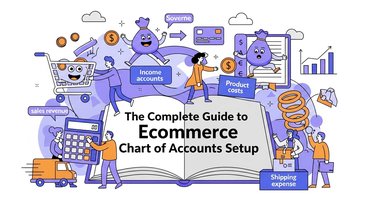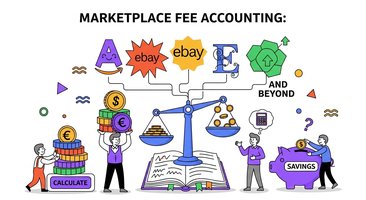Running an ecommerce business means navigating complex financial reporting requirements that can make or break your company's credibility with investors, lenders, and stakeholders. At the heart of these requirements lies a fundamental choice: GAAP or Non-GAAP accounting standards.
This decision isn't just about compliance. It affects how you report revenue, manage investor relations, secure funding, and demonstrate business performance. For ecommerce businesses dealing with multi-channel sales, international transactions, and complex fee structures, understanding both frameworks is essential for long-term success.
Whether you're preparing for an IPO, seeking investment, or simply want to present the most accurate picture of your business performance, this comprehensive guide will help you navigate the critical differences between GAAP and Non-GAAP accounting standards.
What Is GAAP Accounting?
Generally Accepted Accounting Principles (GAAP) represent the standardized framework for financial reporting in the United States. Established by the Financial Accounting Standards Board (FASB) and overseen by the Securities and Exchange Commission (SEC), GAAP provides a consistent set of rules that all publicly traded companies must follow.Think of GAAP as the universal language of business finance. Just as traffic laws create order on highways, GAAP creates order in financial reporting, ensuring that investors, creditors, and other stakeholders can compare companies on an equal footing.
Core GAAP Principles for Ecommerce
Revenue Recognition (ASC 606)
Under GAAP, ecommerce businesses must recognize revenue when control of goods or services transfers to the customer, not necessarily when payment is received. This means:
- Revenue from product sales is typically recognized when items ship to customers
- Subscription revenue must be recognized over the service period
- Gift card sales create liabilities until redeemed
- Returns and refunds must be estimated and accounted for upfront
Consistency Principle
Once you choose an accounting method, you must apply it consistently across all periods. This prevents companies from manipulating results by changing methods to show more favorable outcomes.
Conservatism Principle
When uncertainty exists, GAAP requires choosing the option that is least likely to overstate assets and income. This protects stakeholders from overly optimistic financial reporting.
Full Disclosure Principle
All material information that could influence decision-making must be disclosed in financial statements, even if it presents the company in a less favorable light.
Understanding Non-GAAP Accounting
Non-GAAP accounting refers to any financial reporting method that deviates from standard GAAP principles. These alternative measures are not regulated by the FASB or SEC, giving companies flexibility to present financial information in ways they believe better reflect their true operational performance.Non-GAAP measures are supplementary, not replacement, metrics. Public companies must still prepare GAAP financial statements but can provide additional Non-GAAP metrics to help stakeholders understand their business better.
Common Non-GAAP Adjustments in Ecommerce
Stock-Based Compensation Exclusions
Many ecommerce companies exclude stock-based compensation from their Non-GAAP earnings, arguing that these are non-cash expenses that don't reflect operational cash flow.
Restructuring and One-Time Costs
Companies often remove costs related to acquisitions, restructuring, or other "non-recurring" events to show underlying business performance.
Amortization of Intangible Assets
Some businesses exclude amortization of acquired intangible assets, particularly those from acquisitions, to focus on organic operational performance.
Adjusted EBITDA
Earnings Before Interest, Taxes, Depreciation, and Amortization (EBITDA) is a popular Non-GAAP metric that removes financing and accounting decisions from performance evaluation.
Key Differences Between GAAP and Non-GAAP
Regulatory Requirements
GAAP: Mandatory for all publicly traded companies in the United States. Private companies can choose to follow GAAP but aren't required to do so.
Non-GAAP: Voluntary supplementary reporting. When used, companies must reconcile Non-GAAP figures to the most comparable GAAP measures.
Standardization
GAAP: Highly standardized with specific rules for every industry and transaction type. This ensures comparability across companies and time periods.
Non-GAAP: No standardization. Each company can define its own Non-GAAP measures, making comparisons between companies challenging.
Flexibility
GAAP: Rigid framework with limited flexibility. Changes require extensive justification and disclosure.
Non-GAAP: High flexibility allows companies to highlight metrics they believe best represent their performance.
Audit Requirements
GAAP: Subject to independent audits by certified public accounting firms, providing third-party validation of accuracy.
Non-GAAP: Not audited, though companies must provide reconciliations to GAAP figures and avoid misleading presentations.
GAAP vs Non-GAAP for Ecommerce Revenue Recognition
Revenue recognition presents unique challenges for ecommerce businesses, and the choice between GAAP and Non-GAAP can significantly impact how performance is presented.
GAAP Revenue Recognition for Ecommerce
Under ASC 606, ecommerce businesses must follow a five-step process:
Step 1: Identify the Contract
Every customer purchase creates a contract, whether through your website, mobile app, or marketplace.
Step 2: Identify Performance Obligations
Each distinct product or service promised to the customer represents a separate performance obligation.
Step 3: Determine Transaction Price
The total amount you expect to receive, adjusted for discounts, returns, and variable consideration.
Step 4: Allocate Transaction Price
Distribute the transaction price among all performance obligations based on their standalone selling prices.
Step 5: Recognize Revenue
Record revenue when you satisfy each performance obligation by transferring control to the customer.
Practical GAAP Applications
Multi-Channel Sales
Revenue from Amazon, Shopify, eBay, and direct sales must all follow the same recognition principles, regardless of different fee structures.
Subscription Services
Monthly or annual subscriptions must be recognized ratably over the service period, not when payment is received.
Bundled Products
When selling product bundles, you must allocate revenue to each component based on its standalone selling price.
Non-GAAP Considerations for Ecommerce
Some ecommerce businesses use Non-GAAP measures to provide additional context:
Gross Merchandise Value (GMV)
The total value of merchandise sold, regardless of revenue recognition timing.
Adjusted Revenue
Revenue adjusted for one-time events, returns, or other factors management believes distort operational performance.
Core Commerce Revenue
Revenue from primary business activities, excluding ancillary services or one-time transactions.
Compliance Requirements and Best Practices
GAAP Compliance for Ecommerce
Documentation Requirements
Maintain detailed records of all transactions, contracts, and accounting policies. This includes:
- Customer contracts and terms of service
- Revenue recognition policies and procedures
- Support for all accounting estimates and judgments
- Documentation of internal controls over financial reporting
Regular Policy Reviews
GAAP requirements evolve, particularly for emerging business models. Regular reviews ensure continued compliance.
Professional Expertise
Consider working with CPAs experienced in ecommerce GAAP requirements, especially for complex transactions or new business models.
Non-GAAP Best Practices
Clear Reconciliations
Always provide clear reconciliations between Non-GAAP measures and the most comparable GAAP figures.
Consistent Definitions
Once you define a Non-GAAP measure, use it consistently across periods to maintain credibility.
Avoid Misleading Presentations
Non-GAAP measures should provide additional insight, not obscure poor performance or mislead stakeholders.
Prominent GAAP Disclosure
GAAP figures should be presented with equal or greater prominence than Non-GAAP measures.
Industry-Specific Considerations for Ecommerce
Multi-Channel Revenue Complexity
Ecommerce businesses often sell through multiple channels, each with different fee structures and recognition requirements:
Direct-to-Consumer Sales
Revenue recognized when products ship, with estimates for returns and refunds.
Marketplace Sales (Amazon, eBay)
Revenue recognition may differ based on whether you're the principal (selling your own products) or agent (facilitating sales for others).
Subscription Services
Revenue recognized over the service period, regardless of payment timing.
Digital Products
Revenue typically recognized upon delivery or customer access.
International Considerations
Multiple Accounting Standards
If you operate internationally, you may need to comply with both US GAAP and International Financial Reporting Standards (IFRS).
Currency Translation
Foreign currency transactions must be properly translated and accounted for under GAAP principles.
Transfer Pricing
Inter-company transactions between entities in different countries require careful GAAP compliance.
Technology and Automation
System Requirements
GAAP compliance often requires robust accounting systems capable of handling complex revenue recognition rules.
Automated Controls
Implement automated controls to ensure consistent application of accounting policies across all transactions.
Data Integration
Integrate sales data from all channels to ensure complete and accurate financial reporting.
How Klavena Ensures GAAP and Non-GAAP Compliance
Managing compliance with both GAAP and Non-GAAP requirements can be overwhelming, especially for growing ecommerce businesses. Klavena's comprehensive accounting platform addresses these challenges head-on.
Automated GAAP Compliance
ASC 606 Revenue Recognition
Klavena automatically applies proper revenue recognition principles across all your sales channels, ensuring compliance with ASC 606 requirements.
Multi-Channel Integration
Our platform consolidates data from Amazon, Shopify, eBay, and other channels, applying consistent GAAP principles regardless of the source.
Automated Journal Entries
Generate GAAP-compliant journal entries automatically, reducing errors and ensuring consistency.
Audit Trail Maintenance
Maintain comprehensive audit trails for all transactions, supporting GAAP documentation requirements.
Non-GAAP Reporting Flexibility
Custom MetricsCreate and track custom Non-GAAP metrics that provide insights into your business performance while maintaining proper reconciliations.
Reconciliation Tools
Automatically generate reconciliations between Non-GAAP measures and GAAP equivalents, ensuring transparency and compliance.
Consistent Calculations
Apply Non-GAAP adjustments consistently across periods, maintaining credibility with stakeholders.
Real-Time Compliance Monitoring
Policy Updates
Stay current with evolving GAAP requirements through automatic system updates and notifications.
Exception Reporting
Identify potential compliance issues before they become problems through automated exception reporting.
Professional Support
Access expert guidance on complex GAAP and Non-GAAP issues through our professional services team.
Making the Right Choice for Your Business
When to Use GAAP
Public Companies
If you're publicly traded or planning an IPO, GAAP compliance is mandatory.
Seeking Investment
Investors and lenders often require GAAP financial statements for credibility and comparability.
Regulatory Requirements
Some industries or government contracts require GAAP compliance.
Stakeholder Expectations
When stakeholders expect standardized, comparable financial information.
When to Consider Non-GAAP Supplements
Complex Business Models
When GAAP doesn't fully capture your business's economic reality.
Investor Communication
To help stakeholders understand underlying business performance.
Management Decision-Making
For internal metrics that better guide operational decisions.
Industry Comparisons
When industry peers commonly use specific Non-GAAP measures.
Best Practices for Both
Start with GAAP
Always ensure strong GAAP compliance as your foundation.
Add Non-GAAP Strategically
Use Non-GAAP measures to provide additional insight, not to obscure problems.
Maintain Transparency
Clearly explain all adjustments and provide proper reconciliations.
Stay Consistent
Apply your chosen methods consistently across periods.
Common Mistakes to Avoid
GAAP Compliance Errors
Inconsistent Application
Applying different accounting methods to similar transactions.
Inadequate Documentation
Failing to maintain proper support for accounting policies and estimates.
Revenue Recognition Errors
Misapplying ASC 606 principles to complex ecommerce transactions.
Estimate Accuracy
Using unrealistic estimates for returns, bad debt, or other variables.
Non-GAAP Presentation Issues
Misleading Adjustments
Making adjustments that obscure rather than clarify business performance.
Inconsistent Definitions
Changing Non-GAAP definitions between periods without proper explanation.
Inadequate Reconciliations
Failing to provide clear reconciliations to GAAP measures.
Overemphasis
Presenting Non-GAAP measures more prominently than GAAP figures.
Future Trends in Accounting Standards
Evolving GAAP Requirements
Technology Integration
GAAP standards continue evolving to address new business models and technologies.
ESG Reporting
Environmental, Social, and Governance reporting requirements are expanding.
Digital Assets
New guidance for cryptocurrency and digital asset accounting is developing.
Non-GAAP Evolution
Increased Scrutiny
Regulators are paying closer attention to Non-GAAP measures and their presentation.
Standardization Pressure
Industry groups are pushing for more standardized Non-GAAP metrics.
Technology Enhancement
Better tools are making Non-GAAP reconciliations and presentations more sophisticated.
Conclusion: Building Financial Credibility Through Proper Standards
The choice between GAAP and Non-GAAP accounting isn't binary for most ecommerce businesses. Instead, it's about building a comprehensive financial reporting strategy that serves your stakeholders while accurately representing your business performance.
GAAP provides the credible foundation that investors, lenders, and regulators require. Its standardized approach ensures comparability and transparency, essential for building trust in the financial markets.
Non-GAAP measures, when used responsibly, can provide valuable additional context that helps stakeholders understand your business's unique characteristics and operational performance.
The key is implementing both frameworks correctly, maintaining transparency, and ensuring that your financial reporting enhances rather than obscures your business's true performance.
Ready to ensure both GAAP and Non-GAAP compliance for your ecommerce business? Klavena's comprehensive platform automates complex accounting requirements while providing the flexibility to create meaningful Non-GAAP measures. Our expert team ensures you're always compliant while presenting your business in the best possible light.
Contact Klavena today to learn how we can help you navigate the complexities of ecommerce accounting standards and build the financial credibility your business deserves.





